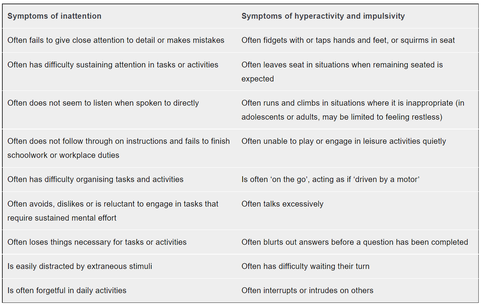Overview of the DSM-5
Medical Classification System
for ADHD
A persistent pattern of inattention and/or hyperactivity-impulsivity that interferes with functioning or development:
For children, six or more of the symptoms (Table) have persisted for at least 6 months to a degree that is inconsistent with developmental level, and that negatively impacts directly on social and academic/occupational activities.
Please note: the symptoms are not solely a manifestation of oppositional behaviour, defiance, hostility or failure to understand tasks or instructions
For older adolescents and adults (age 17 and older), five or more symptoms are required (Table)
Several inattentive or hyperactive-impulsive symptoms present prior to age 12 years
Several inattentive or hyperactive-impulsive symptoms present in two or more settings (e.g. at home, school or work; with friends or relatives; in other activities)
Clear evidence that the symptoms interfere with, or reduce the quality of, social, academic or occupational functioning
Symptoms do not occur exclusively during the course of schizophrenia or another psychotic disorder, and are not better explained by another mental disorder (e.g. mood disorder, anxiety disorder, dissociative disorder, personality disorder, substance intoxication or withdrawal).
For children, six or more of the symptoms (Table) have persisted for at least 6 months to a degree that is inconsistent with developmental level, and that negatively impacts directly on social and academic/occupational activities.
Please note: the symptoms are not solely a manifestation of oppositional behaviour, defiance, hostility or failure to understand tasks or instructions
For older adolescents and adults (age 17 and older), five or more symptoms are required (Table)
Several inattentive or hyperactive-impulsive symptoms present prior to age 12 years
Several inattentive or hyperactive-impulsive symptoms present in two or more settings (e.g. at home, school or work; with friends or relatives; in other activities)
Clear evidence that the symptoms interfere with, or reduce the quality of, social, academic or occupational functioning
Symptoms do not occur exclusively during the course of schizophrenia or another psychotic disorder, and are not better explained by another mental disorder (e.g. mood disorder, anxiety disorder, dissociative disorder, personality disorder, substance intoxication or withdrawal).
American Psychiatric Association: Diagnostic and Statistical Manual of Mental Disorders, Fifth Edition, Text Revision. Washington, DC, American Psychiatric Association, 2013.

